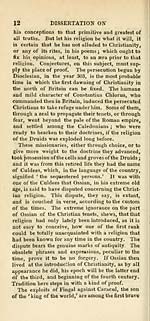Ossian Collection > Poems of Ossian
(61)
Download files
Complete book:
Individual page:
Thumbnail gallery: Grid view | List view

THE JE.RA OF OSSIAN. 13
Sctions of his youth. A complete poem, which re-
lates to this subject, is printed in tliis collection.
In the year 210 the Emperor Severus, after return-
ing from his expedition against the Caledonians,
at York, fell into the tedious illness of which he
afterwards died. The Caledonians and Maiata,
resuming courage from his indisposition, took arms
in order to recover the possessions they had lost.
The enraged Emperor commanded his army to
march into their country and to destroy it with fire
and sword. His orders were but ill executed; for
his son, Caracalla, was at the head of the army, and
his thoughts were entirely taken up with the hopes
of his father's death and with schemes to supplant
his brother Geta. He scarcely had entered the
enemy's country, when news was brought him that
Severus was dead. A sudden peace is patched up
with the Caledonians, and, as it appears from Dion
Cassius, the country they had lost to Severus was
resfbred to them.
The Caracul of Fingal is no other than Caracalla,
who, as the son of Severus, the emperor of Rome,
whose dominions were extended almost over the
known world, was not without reason called the 'son
of the king of the world.' The space of time between
211, the year Severus died, and the beginning of the
fourth century, is not so great, but Ossian, the son
of Fingal, might have seen the Christians whom
the persecution under Dioclesian had driven be-
yond the pale of the Roman empire.
In one of the many lamentations of the death of
Oscar, a battle which he fought against Caros, king
of ships, on the banks of the winding Carun, is
mentioned among his great actions. It is more than
probable, that the Caros mentioned here, is the
same with the noted usurper Carausius, who as-
sumed the purple in the year C87, and, seizing on
Britain, defeated the Emperor Maximinian Hercu-
lius in several naval engagements, which gives pro-
priety to his being called the ' king of ships.' The
' winding Carun' is that small river retaining still
the name of Carron, and runs in the neighbour-
hood of Agricola's wall, which Carausius repaired
Sctions of his youth. A complete poem, which re-
lates to this subject, is printed in tliis collection.
In the year 210 the Emperor Severus, after return-
ing from his expedition against the Caledonians,
at York, fell into the tedious illness of which he
afterwards died. The Caledonians and Maiata,
resuming courage from his indisposition, took arms
in order to recover the possessions they had lost.
The enraged Emperor commanded his army to
march into their country and to destroy it with fire
and sword. His orders were but ill executed; for
his son, Caracalla, was at the head of the army, and
his thoughts were entirely taken up with the hopes
of his father's death and with schemes to supplant
his brother Geta. He scarcely had entered the
enemy's country, when news was brought him that
Severus was dead. A sudden peace is patched up
with the Caledonians, and, as it appears from Dion
Cassius, the country they had lost to Severus was
resfbred to them.
The Caracul of Fingal is no other than Caracalla,
who, as the son of Severus, the emperor of Rome,
whose dominions were extended almost over the
known world, was not without reason called the 'son
of the king of the world.' The space of time between
211, the year Severus died, and the beginning of the
fourth century, is not so great, but Ossian, the son
of Fingal, might have seen the Christians whom
the persecution under Dioclesian had driven be-
yond the pale of the Roman empire.
In one of the many lamentations of the death of
Oscar, a battle which he fought against Caros, king
of ships, on the banks of the winding Carun, is
mentioned among his great actions. It is more than
probable, that the Caros mentioned here, is the
same with the noted usurper Carausius, who as-
sumed the purple in the year C87, and, seizing on
Britain, defeated the Emperor Maximinian Hercu-
lius in several naval engagements, which gives pro-
priety to his being called the ' king of ships.' The
' winding Carun' is that small river retaining still
the name of Carron, and runs in the neighbour-
hood of Agricola's wall, which Carausius repaired
Set display mode to: Large image | Transcription
Images and transcriptions on this page, including medium image downloads, may be used under the Creative Commons Attribution 4.0 International Licence unless otherwise stated. ![]()
| Early Gaelic Book Collections > Ossian Collection > Poems of Ossian > (61) |
|---|
| Permanent URL | https://digital.nls.uk/77989624 |
|---|
| Description | Selected books from the Ossian Collection of 327 volumes, originally assembled by J. Norman Methven of Perth. Different editions and translations of James MacPherson's epic poem 'Ossian', some with a map of the 'Kingdom of Connor'. Also secondary material relating to Ossianic poetry and the Ossian controversy. |
|---|
| Description | Selected items from five 'Special and Named Printed Collections'. Includes books in Gaelic and other Celtic languages, works about the Gaels, their languages, literature, culture and history. |
|---|

